- Types of Sailboats
- Parts of a Sailboat
- Cruising Boats
- Small Sailboats
- Design Basics
- Sailboats under 30'
- Sailboats 30'-35
- Sailboats 35'-40'
- Sailboats 40'-45'
- Sailboats 45'-50'
- Sailboats 50'-55'
- Sailboats over 55'
- Masts & Spars
- Knots, Bends & Hitches
- The 12v Energy Equation
- Electronics & Instrumentation
- Build Your Own Boat
- Buying a Used Boat
- Choosing Accessories
- Living on a Boat
- Cruising Offshore
- Sailing in the Caribbean
- Anchoring Skills
- Sailing Authors & Their Writings
- Mary's Journal
- Nautical Terms
- Cruising Sailboats for Sale
- List your Boat for Sale Here!
- Used Sailing Equipment for Sale
- Sell Your Unwanted Gear
- Sailing eBooks: Download them here!
- Your Sailboats
- Your Sailing Stories
- Your Fishing Stories
- Advertising
- What's New?
- Chartering a Sailboat
- Cruising Yachts 30' to 35'
- Westsail 32

The Westsail 32 Sailboat
The Westsail 32, a heavy displacement long-keeled cutter, was designed by William Crealock and built in the USA by the Westsail Corporation.
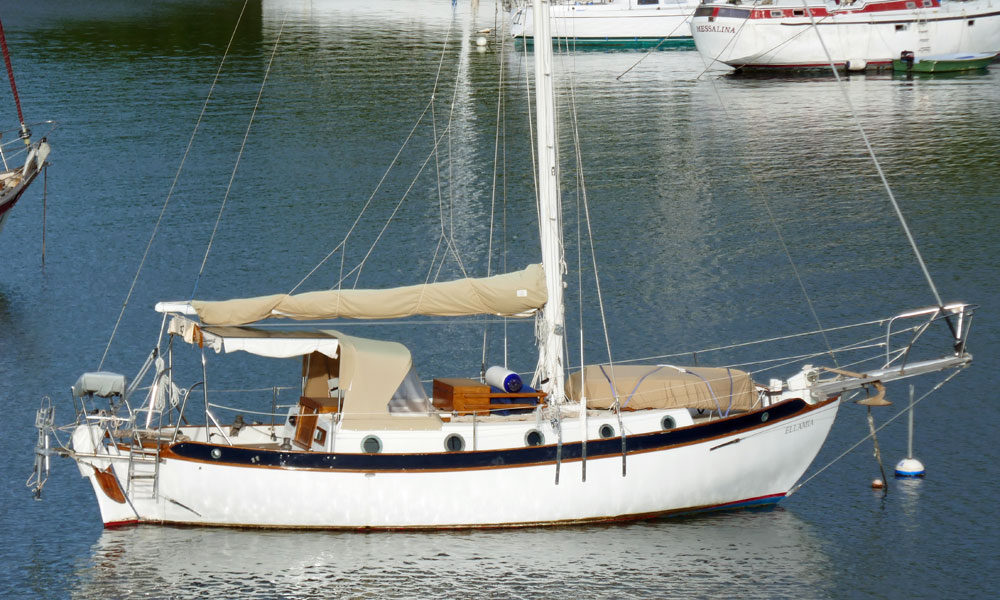
Published Specification for the Westsail 32
Underwater Profile: Long keel with transom-hung rudder
Hull Material: GRP
Length Overall: 32'0" / 9.75m
Waterline Length: 27'6" / 8.4m
Beam: 11'0" / 3.4m
Draft: 5'0" / 1.5m
Rig Type: Cutter
Displacement: 19,500lb / 8,845kg
Designer: Bill Crealock
Builder: Westsail Corporation. (USA)
Year First Built: 1971
Year Last Built: 1981
Number Built: 830
Owners Association: Westsail Owners Association
Published Design Ratios for the Westsail 32
1. Sail Area/Displacement Ratio: 16.7
- Less than 16 would be considered under-powered;
- 16 to 20 would indicate reasonably good performance;
- Over 20 suggests relatively high performance.
2. Ballast/Displacement Ratio: 36.0
- Under 40: less stiff, less powerful
- Over 40: stiffer, more powerful
3. Displacement/Length Ratio: 419
- Under 100: Ultralight
- 100 to 200: Light
- 200 to 275: Moderate
- 275 to 350: Heavy
- Over 350: Ultraheavy
4. Comfort Ratio: 42.9
- Under 20 indicates a lightweight racing boat
- 20 to 30 indicates a coastal cruiser
- 30 to 40 indicates a moderate offshore cruising boat
- 40 to 50 indicates a heavy offshore boat
- Over 50 indicates an extremely heavy offshore boat
5. Capsize Screening Formula: 1.6
- Under 2.0 (the lower the better): Better suited for ocean passages
- Over 2.0: Less suited for ocean passages
read more about these all-revealing numbers...
Summary Analysis of the Design Ratios for the Westsail 32
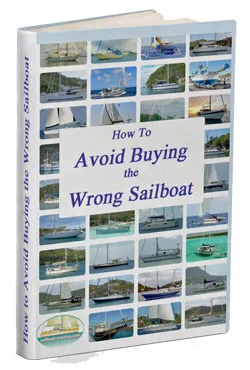
1. A Sail Area/Displacement Ratio of 16.7 suggests that the Westsail 32 will approach her maximum hull speed readily and satisfy the sailing performance expectations of most cruising sailors.
2. A Ballast/Displacement Ratio of 36.0 means that unless the bulk of the ballast is concentrated in a bulb at the foot of her keel, the Westsail 32 will have a tendency to heel excessively in a gust, and she'll need to be reefed early to keep her sailing upright in a moderate breeze.
3. A Displacement/Length Ratio of 419, tells us the Westsail 32 is firmly in the ultra-heavy displacement category. Load her up as much as you like and her performance will be hardly affected, not that it was ever startling. Few if any sailboats are built to this displacement category these days - but they remain popular with some long-distance sailors.
4. Ted Brewer's Comfort Ratio of 42.9 suggests that crew comfort aboard a Westsail 32 in a seaway is similar to what you would associate with the motion of a heavy bluewater cruising boat. Pitching and rolling will be well damped - your cup of coffee on the salon table stands a reasonable chance of staying there in most conditions.
5. The Capsize Screening Formula (CSF) of 1.6 tells us that a Westsail 32 would be a safer choice of sailboat for an ocean passage than one with a CSF of more than 2.0.
Cruisers' Questions about this Sailboat...
What is the design origin of the Westsail 32?
The Westsail 32 design has a long history. The hull shape is descended from the double-ended pilot and rescue boats designed by the Norwegian naval architect Colin Archer. These boats were designed for extreme seaworthiness in the rough conditions of the North Sea. The late 19th century Archer design was first adapted for pleasure sailing by William Atkin, who, in 1928, designed a 32-foot (9.8 m) double-ended boat called Eric based on Archer's 47’ rescue boat design. This design was later refined into Thistle , which replaced Eric's gaff rig with a bermuda rig, and has a flush deck. The Westsail 32 was directly derived from the earlier Kendall 32, of which only a few were made, and was adapted for fibreglass construction by William Crealock.
How fast is the Westsail 32?
The Westsail 32 is not known for being a fast boat, but rather for being a sturdy and reliable one. She has a hull speed of about 7 knots (13 km/h), but her average speed in cruising conditions is likely to be lower, depending on the wind, waves, and load. She can carry a lot of weight without affecting her performance too much, which makes her ideal for long-distance voyages.
How seaworthy is the Westsail 32?
The Westsail 32 is widely regarded as one of the most seaworthy sailboats ever built. She has a reputation for being able to handle any weather and sea condition, and for being able to survive storms that would sink other boats. Her double-ended hull shape, heavy displacement, and low center of gravity make her stable and resistant to broaching and capsizing. Her thick fiberglass hull and solid construction make her strong and durable. Many Westsail 32 owners have sailed across oceans and around the world in their boats, proving their seaworthiness.
How comfortable is the Westsail 32?
The Westsail 32 has a spacious and cozy interior, with plenty of headroom, storage space, and ventilation. She can accommodate up to seven people, although four or five would be more comfortable. She has a V-berth forward, followed by a head with shower, a main saloon with two settees that can convert to berths, a U-shaped galley to port, and a quarter berth to starboard.
How much does the Westsail 32 cost?
The price of a Westsail 32 depends on the condition, equipment, and location of the boat. A new Westsail 32 kit cost about $12,000 in the early 1970s, but most owners spent much more to finish and outfit their boats. A used Westsail 32 can range from $20,000 to $80,000 or more today, depending on the market and the quality of the boat.
Where can I learn more about the Westsail 32?
Tere are many resources available for anyone interested in learning more about the Westsail 32. Some of them are:
- The book "Westsail: The World's Best Sailboat" by Bud Taplin, the former general manager of Westsail Corporation and the current owner of Worldcruiser Yacht Company, which provides parts and services for Westsail boats;
- The website of " Worldcruiser Yacht Company" , which has a lot of information, photos, and videos about the Westsail 32 and other Westsail models.
- The website of the "Westsail Owners Association" , which has a forum, a newsletter, a registry, and other resources for Westsail owners and enthusiasts.
- The Facebook group "Westsail Owners Group" , which has over 2,000 members who share their experiences, advice, and photos of their Westsail boats.
- The YouTube channel "Westsail 32" , which has dozens of videos of Westsail 32 boats sailing, cruising, and being restored.
The above answers were drafted by sailboat-cruising.com using GPT-4 (OpenAI’s large-scale language-generation model) as a research assistant to develop source material; to the best of our knowledge, we believe them to be accurate.
Recent Articles
The CSY 44 Sailboat
Sep 15, 24 08:18 AM
Hallberg-Rassy 41 Specs & Key Performance Indicators
Sep 14, 24 03:41 AM
Amel Kirk 36 Sailboat Specs & Key Performance Indicators
Sep 07, 24 03:38 PM
Here's where to:
- Find Used Sailboats for Sale...
- Find Used Sailing Gear for Sale...
- List your Sailboat for Sale...
- List your Used Sailing Gear...
Our eBooks...

A few of our Most Popular Pages...

Copyright © 2024 Dick McClary Sailboat-Cruising.com

- Compare Sailboats
- Sailboat Calculators
- Bluewater Sailboats
- Catamarans and Multihulls
- Sailing Liveaboard
- Sailboats Galley
- How Much it Costs
- Sailing Destinations
- Meteorology Terms
- Sailing and Nautical Terms
- Parts of a Sailboat
- Great Explorers
- People of the Seas
Bluewater Sailboat – Westsail 32
The Bluewater Sailboat Westsail 32 is known as the boat that sparked a million dreams. She is largely recognized as having launched the cruising boom of the 1970s, which elevated “the cruising life” from the extremes to the mainstream.
The epitome of seaworthiness, this boat was designed by Bill Crealock as a big displacement double-ender for long-distance traveling. It is robust, hefty, and has a large internal volume. She lacks agility; she moves slowly around turns and accelerates slowly. Boat speed was frequently low in the early years since she was frequently sailed by beginners on sloppy rigs, and among bluewater sailors, she was mocked as the “Wet-snail 32.”
However, that kind of brand recognition has been shaken off in recent years. The Westsail 32 can astound when sailed skillfully.

- LOA: 42′ 11″
- LWL: 33′ 4″
- Beam: 13′ 0″
- Draft: 5′ 8″
- Ballast: 11,000 lbs.
- Displacement: 31,500 lbs.
- Sail Area, Cutter: 961 sq.ft.
- Sail Area, Ketch: 1081 sq.ft.
- Bridge Clearance, Cutter: 60′ 0″
- Bridge Clearance, Ketch: 57′ 4″
- Fuel: 150 Gal US
- Water: 250 Gal US
- Engine: Perkins 4-236 85hp diesel
- Year Introduced: 1974
- Year Ended: 1979
- Total Built: 119
- Designer: William I. B. Crealock
- Builder: Westsail Corporaton – Jomarco
When Larry Kendall approached Crealock to design a heavy-capacity offshore sailboat in the style of William Aitken’s renowned 32-foot double enders Eric and Thistle, the Westsail 32 initially began as a flush-deck Kendall 32. When asked to estimate the value of the market for such a boat, Crealock reportedly answered 10–12 boats. The Kendall 32 was introduced in 1969, and with a run of 30 boats, production outperformed Crealock’s expectations.
Sales didn’t really take off until 1971 when a young electrical engineer who later became a boatbuilder by the name of Snyder Vick bought the molds. He had Crealock add a cabin house and change the interior as well as the deck layout. The new business was given the name Westsail Corporation, and the new ship was given the name Westsail 32. The catchphrase for the advertising campaign, “Westsail the world,” exuded adventure in exotic locales. The marketing campaign was so effective that by June 1973 Time Magazine had a four-page spread on “the cruising life” with a prominent photograph of a Westsail 32 in an appropriately exotic background. The American people were captivated by it. The boat achieved astounding sales, and in the process, it permanently altered the design and appearance of American bluewater cruising boats for almost two decades.
Westsail constructed 830 boats in all. Around 400 of these boats were offered as hull and deck kits to meet demand; their interiors had to be finished by the individual buyers. Hull and Deck, Sail-Away, and complete boat kits were all available for purchase. Owners could add any option they desired, such as ballast, bulkheads, rigging, etc., with kits.
Even though the Westsail 32 was an unstoppable marketing hit, the business did not prosper financially. The corporation was severely impacted by the 1970s petroleum crisis. They conducted their sales by accepting boat orders at set pricing and fulfilling them in the order they were received. This meant that the business was offering boats for sale at prices that were significantly out of date even up to 18 months later. The business stopped doing business in 1981. Before production was finally halted, the molds were sold to P&M Worldwide and additional 15 boats were offered as kits.
Structure
The hull’s thickness varies from 3/4 inches near the topsides to 1 1/8 inches at the turn of the bilge due to the heavy use of hand-laid fibreglass in 12 layers with polyester resin. Marine plywood that is tabbed to the hull with fibreglass makes up the 3/4″ bulkheads.
The amount of ballast on each boat varied, but it was usually at least 7,000 pounds. Some of them contained 5,000 pounds of punching steel and 2,000 pounds of lead. Three sections of cast lead were utilised in the keel cavity beginning in 1974. The keel sump is substantially deeper beneath the engine pan, which makes it easy to identify the lead ballast.
The deck and cabin trunk is fiberglass cored with two layers of half inch plywood, with an extra two inch plywood base to reinforce below the mast step. Many boats had teak decks at unbelievably thick (and heavy) 13/16 inches. There were three versions of the deck molds. The first mold had a forward hatch and large heavy sliding companionway with a lazarette hatch that sat up above the deck. The second mold added a center skylight hatch, and the last mold added a cockpit locker, flush lazarette hatch, and tapered black anodized aluminum stanchions with aluminum built into the mold for easy on-off removal.
Later hulls had fiberglass gudgeons, earlier hulls had stainless steel gudgeons with a bronze pintal. The hull-to-deck join with its substantial bulwark is strong, though not impervious to leaking.
Now you can also precisely calculate the expenses related to boat ownership to make smart choices based on your budget and sailing needs. Use this bluewater Sailboat Calculator to explore different options and make the best decision.
Performance
The Westsail 32 has a reputation for bringing cruisers to their desired destinations, however slowly. Most owners believe that this is not what they truly deserve. The ride has been criticized by some for being too wet, although the motion through the water is comfortable. This frequently happens when boat owners overload them. Although the yacht can carry everything she needs for pleasant cruising, putting her below her water line will have an impact. According to some owners, the cockpit seats are flush with the side decks, which means that any water that channels down the side deck will likely wet your bottom (some custom boats have this problem solved with a cockpit coaming). Additionally, a 3″ hawse pipe installed midships on later models prevented a lot of water from entering the cockpit.
The boat tracks well, as with many full-keeled boats, but pays this off for maneuverability, both when powered and when covered in canvas. Due to its enormous wetted area, acceleration is slow, and light weather performance (without the right sail combination) isn’t exactly impressive; the boat needs to be traveling at least 10 mph before it begins to move smoothly. The boat can reach its hull speed of 7 knots at its best point of sail, which is a beam to broad reach between 90 and 120 degrees off the wind with an ideal heal angle of 20 degrees.
The ship had a bad reputation when it first started sailing, but it probably not fully entirely deserved. Many owners lacked the sailing expertise necessary to get a heavy displacement boat to function well. The headsails and mainsails on the early rigs weren’t sized properly, making them less than ideal. Due to its weather helm, the boat developed notoriety.
The Westsail 32 has reversed the slow reputation it had had in more recent years. Given the light wind conditions that year, David King’s captaining of the Westsail 32 Saraband to a Trans-Pacific Cup success in 1988 was impressive. In addition, owners have reportedly recorded weeklong runs of 140 to 160 mile days while sailing in trade winds. Despite record runs, the majority of owners may anticipate traveling on average 110 miles per day when trading.
Quick Notes
There haven’t been many structural issues with the Westsail 32 over the years. Osmotic blisters, which develop on older boats, are not a problem with the Westsail because of its sturdy hull.
The fuel tanks should be examined, especially if they are made of black iron. The bottom fittings on the boomkin and the bobstay are additional areas that merit inspection. Inspect the plywood-cored decking for indications of rot, as well as the mast step for indications of fibreglass compression. If the standing rigging is original, as with any older boat, think about replacing them.
Look for a boat with 35 horsepower or more; the original 25-horsepower Volvo MD2B is frequently cited as being insufficient for long-distance driving in harsh weather.
Looking for a used sailboat for sale? Check out the Bluewater sailboat data and specs to make an informed decision. Ocean Wave Sail has data for over 10000+ boats that can help you select one to meet your sailing needs.
Subscribe to our newsletter
Don’t miss new updates on your email.
© OceanWave Sail. All Rights Reserved 2022
Terms & Conditions – Privacy Policy – Cookie Policy
About Us – Privacy Policy
- New account
Forgot your password?
Lost your password? Please enter your email address. You will receive mail with link to set new password.
Back to login
Privacy Overview
| Cookie | Duration | Description |
|---|---|---|
| _GRECAPTCHA | 5 months 27 days | This cookie is set by the Google recaptcha service to identify bots to protect the website against malicious spam attacks. |
| apbct_cookies_test | session | CleanTalk sets this cookie to prevent spam on comments and forms and act as a complete anti-spam solution and firewall for the site. |
| apbct_page_hits | session | CleanTalk sets this cookie to prevent spam on comments and forms and act as a complete anti-spam solution and firewall for the site. |
| apbct_prev_referer | session | Functional cookie placed by CleanTalk Spam Protect to store referring IDs and prevent unauthorized spam from being sent from the website. |
| apbct_site_landing_ts | session | CleanTalk sets this cookie to prevent spam on comments and forms and act as a complete anti-spam solution and firewall for the site. |
| apbct_site_referer | 3 days | This cookie is placed by CleanTalk Spam Protect to prevent spam and to store the referrer page address which led the user to the website. |
| apbct_timestamp | session | CleanTalk sets this cookie to prevent spam on comments and forms and act as a complete anti-spam solution and firewall for the site. |
| apbct_urls | 3 days | This cookie is placed by CleanTalk Spam Protect to prevent spam and to store the addresses (urls) visited on the website. |
| cookielawinfo-checkbox-advertisement | 1 year | Set by the GDPR Cookie Consent plugin, this cookie is used to record the user consent for the cookies in the "Advertisement" category . |
| cookielawinfo-checkbox-analytics | 11 months | This cookie is set by GDPR Cookie Consent plugin. The cookie is used to store the user consent for the cookies in the category "Analytics". |
| cookielawinfo-checkbox-functional | 11 months | The cookie is set by GDPR cookie consent to record the user consent for the cookies in the category "Functional". |
| cookielawinfo-checkbox-necessary | 11 months | This cookie is set by GDPR Cookie Consent plugin. The cookies is used to store the user consent for the cookies in the category "Necessary". |
| cookielawinfo-checkbox-others | 11 months | This cookie is set by GDPR Cookie Consent plugin. The cookie is used to store the user consent for the cookies in the category "Other. |
| cookielawinfo-checkbox-performance | 11 months | This cookie is set by GDPR Cookie Consent plugin. The cookie is used to store the user consent for the cookies in the category "Performance". |
| CookieLawInfoConsent | 1 year | Records the default button state of the corresponding category & the status of CCPA. It works only in coordination with the primary cookie. |
| ct_checkjs | session | CleanTalk–Used to prevent spam on our comments and forms and acts as a complete anti-spam solution and firewall for this site. |
| ct_fkp_timestamp | session | CleanTalk sets this cookie to prevent spam on the site's comments/forms, and to act as a complete anti-spam solution and firewall for the site. |
| ct_pointer_data | session | CleanTalk sets this cookie to prevent spam on the site's comments/forms, and to act as a complete anti-spam solution and firewall for the site. |
| ct_ps_timestamp | session | CleanTalk sets this cookie to prevent spam on the site's comments/forms, and to act as a complete anti-spam solution and firewall for the site. |
| ct_sfw_pass_key | 1 month | CleanTalk sets this cookie to prevent spam on comments and forms and act as a complete anti-spam solution and firewall for the site. |
| ct_timezone | session | CleanTalk–Used to prevent spam on our comments and forms and acts as a complete anti-spam solution and firewall for this site. |
| elementor | never | This cookie is used by the website's WordPress theme. It allows the website owner to implement or change the website's content in real-time. |
| JSESSIONID | session | The JSESSIONID cookie is used by New Relic to store a session identifier so that New Relic can monitor session counts for an application. |
| viewed_cookie_policy | 11 months | The cookie is set by the GDPR Cookie Consent plugin and is used to store whether or not user has consented to the use of cookies. It does not store any personal data. |
| Cookie | Duration | Description |
|---|---|---|
| _zcsr_tmp | session | Zoho sets this cookie for the login function on the website. |
| Cookie | Duration | Description |
|---|---|---|
| __gads | 1 year 24 days | The __gads cookie, set by Google, is stored under DoubleClick domain and tracks the number of times users see an advert, measures the success of the campaign and calculates its revenue. This cookie can only be read from the domain they are set on and will not track any data while browsing through other sites. |
| _ga | 2 years | The _ga cookie, installed by Google Analytics, calculates visitor, session and campaign data and also keeps track of site usage for the site's analytics report. The cookie stores information anonymously and assigns a randomly generated number to recognize unique visitors. |
| _ga_SMBZQHCWN2 | 2 years | This cookie is installed by Google Analytics. |
| _ga_W40VWSXK09 | 2 years | This cookie is installed by Google Analytics. |
| _gat_gtag_UA_231294427_1 | 1 minute | Set by Google to distinguish users. |
| _gid | 1 day | Installed by Google Analytics, _gid cookie stores information on how visitors use a website, while also creating an analytics report of the website's performance. Some of the data that are collected include the number of visitors, their source, and the pages they visit anonymously. |
| CONSENT | 2 years | YouTube sets this cookie via embedded youtube-videos and registers anonymous statistical data. |
| Cookie | Duration | Description |
|---|---|---|
| test_cookie | 15 minutes | The test_cookie is set by doubleclick.net and is used to determine if the user's browser supports cookies. |
| Cookie | Duration | Description |
|---|---|---|
| __gpi | 1 year 24 days | No description |
| 1e5a17c8ab | session | No description available. |
| apbct_headless | session | No description |
| apbct_pixel_url | session | No description |
| ct_checked_emails | session | No description |
| ct_has_scrolled | session | No description |
| ct_screen_info | session | No description |
| ZCAMPAIGN_CSRF_TOKEN | session | No description available. |
Westsail 32
The westsail 32 is a 32.0ft cutter designed by william crealock/w. atkin and built in fiberglass by westsail corporation (usa) between 1971 and 1981., 834 units have been built..
The Westsail 32 is a very heavy sailboat which is a reasonably good performer. It is stable / stiff and has an excellent righting capability if capsized. It is best suited as a heavy bluewater cruising boat. The fuel capacity is originally small. There is a short water supply range.
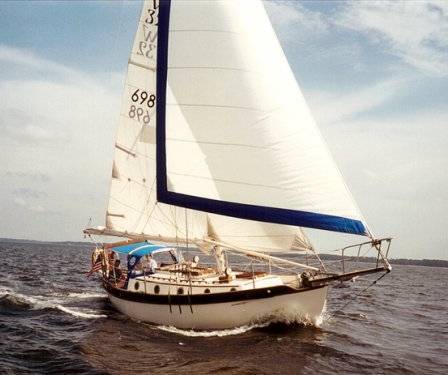
Westsail 32 for sale elsewhere on the web:

Main features
| Model | Westsail 32 | ||
| Length | 32 ft | ||
| Beam | 11 ft | ||
| Draft | 5 ft | ||
| Country | United states (North America) | ||
| Estimated price | $ 0 | ?? |
Login or register to personnalize this screen.
You will be able to pin external links of your choice.

See how Sailboatlab works in video
| Sail area / displ. | 16.69 | ||
| Ballast / displ. | 35.90 % | ||
| Displ. / length | 418.59 | ||
| Comfort ratio | 42.85 | ||
| Capsize | 1.64 |
| Hull type | Monohull long keel with transom hung rudder | ||
| Construction | Fiberglass | ||
| Waterline length | 27.50 ft | ||
| Maximum draft | 5 ft | ||
| Displacement | 19500 lbs | ||
| Ballast | 7000 lbs | ||
| Hull speed | 7.03 knots |

We help you build your own hydraulic steering system - Lecomble & Schmitt
| Rigging | Cutter | ||
| Sail area (100%) | 753 sq.ft | ||
| Air draft | 0 ft | ?? | |
| Sail area fore | 402.60 sq.ft | ||
| Sail area main | 302.75 sq.ft | ||
| I | 44 ft | ||
| J | 18.30 ft | ||
| P | 38.25 ft | ||
| E | 15.83 ft |
| Nb engines | 1 | ||
| Total power | 36 HP | ||
| Fuel capacity | 42 gals |
Accommodations
| Water capacity | 80 gals | ||
| Headroom | 6.17 ft | ||
| Nb of cabins | 0 | ||
| Nb of berths | 0 | ||
| Nb heads | 0 |
Builder data
| Builder | Westsail Corporation (USA) | ||
| Designer | William Crealock/W. Atkin | ||
| First built | 1971 | ||
| Last built | 1981 | ||
| Number built | 834 |
Other photos
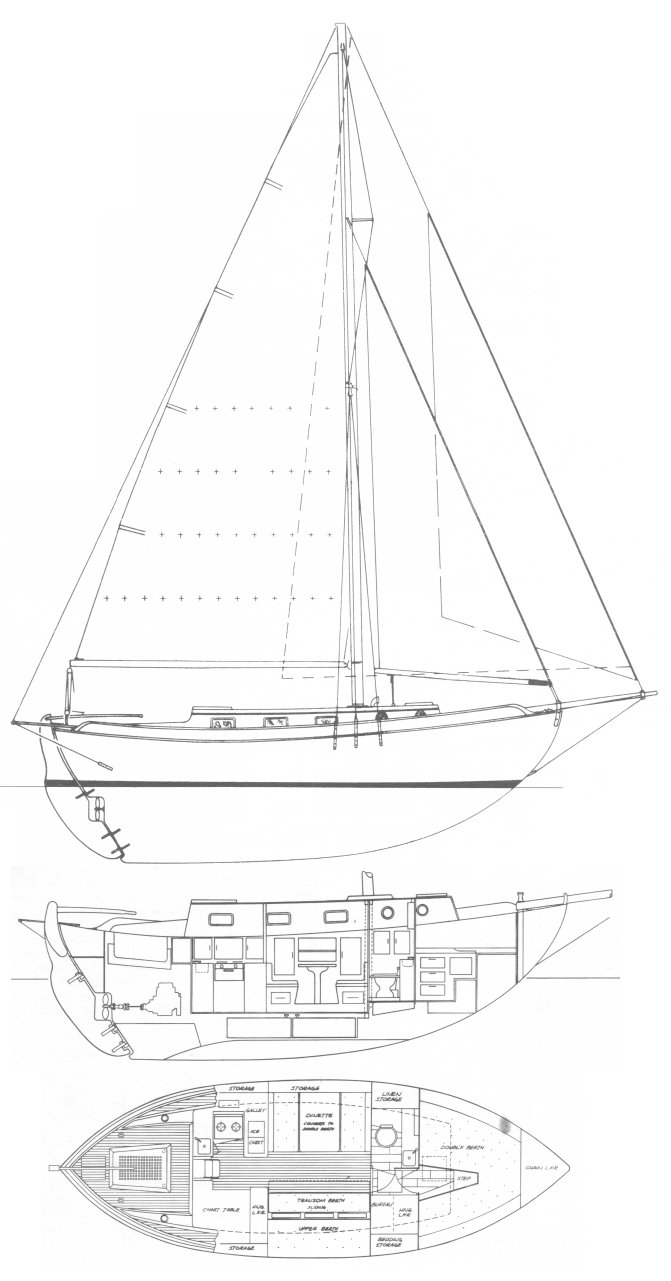
Modal Title
The content of your modal.
Personalize your sailboat data sheet
- Past International
- Boats for Sale
- Circumnavigators
- Westsail Parts Company
- Westsail Personalities
- Westsail 32 Inch
- Westsail 28
- Westsail 32
- Westsail 39
- Westsail 43
- Westsail 63
- Windjammer 34
- Westsail 42/43
- In the Yard
- Gear for the Boat
- The Iron Genny
- Looking to Buy
- Cruising Stories and Destination Info
- Singlehanded Sailing Tips
- Racing / Rally with Westsails
| Email Password |

Blue Water Boats article on the Westsail 32 - with comments by WOA members. Sail Boat Data Rob Lawson - Good Old Boat Articles Westsail Corp pamphlet on the Westsail 32 Westsail 32 Video's Westsail 32 Order forms - with prices
Dick and Libby Mills are aboard W32 Tarwathie and as live aboards are cruising up and down the eastern seaboard of the US for about 5 years. T heir blog can be found at http://dickandlibby.blogspot.com/ . Dick and Libby sold there boat several years ago 9/21/2022 djb
WOA YouTube channel Westsail Parts Company Westsail on Facebook

1974 Westsail 32 Technical Specs
General data about westsail 32.
| Brand | |
| Model | |
| Boat Type | |
| Category | |
| Year Of Production | |
| Condition (New/Used) | |
| Country | |
| Fuel (Gas/Diesel) | |
| Hull Material Used | |
| Length | |
| Selling Price | |
| Vat Status | |
Engine and Power Specs
| Engine manufacturer | |
| Engine Series | |
| Engine Location | |
| Engine Hours |
Dimensions And Wieght
| LOA (Length Overall) | |
| L.W.L(Length WaterLine) | |
| Dry Weight (Empty) | |
| Boat Keel Type | |
| Beam Width |
Detailed Specifications
| Numebr of Cabins | |
| Hull Type and Design | |
| Gas Tank Size | |
| Drinking Water Tank | |
| Berth (Mono/Single) |
Features And Equipments
Sailing features.
| Reefing mainsail |
| Headsail |
| Covers - sail |
Safety Features
| Propane storage |
| Mirror |
| Grab rails |
| Engine kill switch |
Other Equipments
| Winches - manual |
| Vhf radio |
| Vhf antenna |
| Standing rigging |
| Running rigging |
| Rigging hardware |
| Radar arch |
| Navigation lights |
| Mast |
| Lifelines |
| Gps / plotter |
| Covers - display |
| Chain plates |
| Boom |
| Blocks |
Interior Specifications
| Water system - foot pump |
| V berth |
| Stove / oven |
| Sink - galley |
| Settee |
| Salon |
| Pressurized water system |
| Port holes |
| Ice box |
| Hanging locker |
| Fridge/freezer |
| Dinette |
| Composting toilet |
| Cabinets |
| Cabin lighting |
Engine And Mechanical Specs
| Water tanks |
| Throttle/shift: mech |
| Rudder |
| Number of eng cylinders |
| Fuel injected |
| Engine alarms |
| Closed water cooling sys |
| Bilge pump |
| 38.0 hp |
Electronical And Electrical Info
| Volt meter |
| Tachometer |
| Stereo |
| Solar panel |
| Shore power |
| Hour meter |
| Fuse panel |
| Compass steering |
| Battery tender |
| Battery switch |
| Ac electric panel |
| 12 v dc outlets |
| 110v ac outlets |
Deck Hardware
| Windlass |
| Swim ladder |
| Self bailing cockpit |
| Sea cocks |
| Non-skid deck |
| Isinglass |
| Dodger |
| Compartment storage |
| Cockpit seating |
| Cleats - fixed |
| Bow rail |
| Bow pulpit |
| Anchor |
Westsail 32

More 32 models
- Westsail provided us with the latest version of its 32 service repair manual
- Find All mechanical and electrical parts and accessories of Westsail 32 Sail here
Westsail 32 competitors

Great choice! Your favorites are temporarily saved for this session. Sign in to save them permanently, access them on any device, and receive relevant alerts.
- Sailboat Guide


1973 Westsail 32
- Description
Seller's Description
This 1973 Westsail 32 features a custom interior.
The interior woodwork was done by a master craftsman.
The boat’s interior has so much storage space. There are more cabinets and spaces for everything than I have ever seen.
This Westsail is powered by an Isuzu 32-horsepower diesel engine.
The boat features a long keel with a transom-hung rudder and a long tiller that is perfect for a single person to sail this boat.
This sailboat has new navigation and an updated inverter.
Rig and Sails
Auxilary power, accomodations, calculations.
The theoretical maximum speed that a displacement hull can move efficiently through the water is determined by it's waterline length and displacement. It may be unable to reach this speed if the boat is underpowered or heavily loaded, though it may exceed this speed given enough power. Read more.
Classic hull speed formula:
Hull Speed = 1.34 x √LWL
Max Speed/Length ratio = 8.26 ÷ Displacement/Length ratio .311 Hull Speed = Max Speed/Length ratio x √LWL
Sail Area / Displacement Ratio
A measure of the power of the sails relative to the weight of the boat. The higher the number, the higher the performance, but the harder the boat will be to handle. This ratio is a "non-dimensional" value that facilitates comparisons between boats of different types and sizes. Read more.
SA/D = SA ÷ (D ÷ 64) 2/3
- SA : Sail area in square feet, derived by adding the mainsail area to 100% of the foretriangle area (the lateral area above the deck between the mast and the forestay).
- D : Displacement in pounds.
Ballast / Displacement Ratio
A measure of the stability of a boat's hull that suggests how well a monohull will stand up to its sails. The ballast displacement ratio indicates how much of the weight of a boat is placed for maximum stability against capsizing and is an indicator of stiffness and resistance to capsize.
Ballast / Displacement * 100
Displacement / Length Ratio
A measure of the weight of the boat relative to it's length at the waterline. The higher a boat’s D/L ratio, the more easily it will carry a load and the more comfortable its motion will be. The lower a boat's ratio is, the less power it takes to drive the boat to its nominal hull speed or beyond. Read more.
D/L = (D ÷ 2240) ÷ (0.01 x LWL)³
- D: Displacement of the boat in pounds.
- LWL: Waterline length in feet
Comfort Ratio
This ratio assess how quickly and abruptly a boat’s hull reacts to waves in a significant seaway, these being the elements of a boat’s motion most likely to cause seasickness. Read more.
Comfort ratio = D ÷ (.65 x (.7 LWL + .3 LOA) x Beam 1.33 )
- D: Displacement of the boat in pounds
- LOA: Length overall in feet
- Beam: Width of boat at the widest point in feet
Capsize Screening Formula
This formula attempts to indicate whether a given boat might be too wide and light to readily right itself after being overturned in extreme conditions. Read more.
CSV = Beam ÷ ³√(D / 64)
From BlueWaterBoats.org :
The Westsail 32 goes down in history as the boat that launched a thousand dreams. She’s generally credited for starting the cruising boom of the 1970s which brought “the cruising life” out of the fringes and into the mainstream. Designed by Bill Crealock as a heavy displacement double ender for long distance cruising, this boat is the epitome of seaworthiness; built strong and heavy with huge interior volume. The trade off is in nimbleness; she is slow through the tacks and slow to accelerate. In the early years, often sailed by beginners on badly setup rigs, boat speed was often lacking and she was ridiculed as the “Wet-snail 32” among the bluewater sailing fraternity, however some of this reputation has been shrugged off in recent years. When sailed well the Westsail 32 can surprise.
The Westsail 32 started out life as a flush-deck Kendall 32 when Larry Kendall approached Crealock to design a heavy displacement offshore sailboat along the lines of William Aitken’s famous 32 foot double enders Eric and Thistle . It’s said when asked how big the market for such a boat, Crealock estimated 10-12 boats. The Kendall 32 was introduced in 1969 and production exceeded Crealock’s estimates with a run of 30 boats.
It wasn’t until 1971 when a young electrical engineer turned boatbuilder by the name of Snyder Vick who bought the molds did sales begin to take off. He had Crealock redesign the deck layout, adding a cabin house and a revised interior. The new company became Westsail Corporation and the new boat was dubbed the Westsail 32. “Westsail the world” was the advertising mantra, oozing adventure in far away places. So successful was the marketing campaign that by June of 1973 Time Magazine featured a four page spread on “the cruising life” including a large image of a Westsail 32 in a suitably exotic location. It caught the imagination of the American public. The boat sold in incredible numbers, and along the way set in stone the shape and style of American bluewater cruising boats for nearly two decades.
In total 830 boats were produced by Westsail. To keep up with demand around 400 of these boats were sold as hull and deck kits; requiring interior finishing by their respective purchasers. Kits were sold in various stages of completion; Hull and Deck, Sail-Away, and a complete boat. With kits owners could add any option they felt they wanted including ballast, bulkheads, rigging, etc.
Although the Westsail 32 was a runaway marketing success, the company did not enjoy financial success. The petroleum crunch of the 1970’s hit the company hard. Their sales process involved taking orders for boats at fixed prices and selling them out in the order in which they received them. This meant that the company was selling boats up to eighteen months later at prices that were considerably outdated. The company ceased operations in 1981. The molds got sold to P&M Worldwide and another 15 boats were sold in kit form before production finally ceased.
Configuration & Layout
The Westsail 32 follows a long line of traditional double-enders dating back to Colin Archer’s famous 19th century Norwegian pilot boat Regis Voyager which itself was influenced by Archer’s earlier work with designing lifeboats.
A cutter rig sits on top with a bowsprit forward and on some boats a boomkin astern. Below the waterline is a very full keel drawing 5 feet.
The deck arrangement has offshore work in mind. The lifelines are high and the high bulwark combine to provide a sense of security on the foredeck. The cockpit is suitably tiny as was the thinking for blue water sailboats, but it gets crowded quickly with more than two people.
Down below, there’s an enormous interior volume, definitely one of the largest and most livable interiors for 32 feet. There is a huge V-berth forward followed by the head, a port side dinette and starboard settee and a U-shaped galley to port and a starboard navigation station and quarter berth aft. An optional interior featured opposing settees and a centerline table. Later mods included a change in the head configuration and a sit down chart table.
The joinery was aimed more for function than all out beauty and the factory finish varied through the years. Many of the kit boats were finished by their owners superbly, however some are in serious need of TLC.
Construction
The hull is heavily built from hand-laid fiberglass in 12 layers with polyester resin resulting in a hull that ranges from 3/4 inch near the topsides to 1 1/8 inches at the turn of the bilge. The 3/4″ bulkheads are marine plywood and tabbed to the hull with fiberglass.
Ballast varied between boats, but always with at least 7,000 pounds. Some had 2,000 pounds of lead and 5,000 pounds of steel punchings. From 1974, cast lead was used in the keel cavity in three sections. One can easily tell the lead ballast because the keel sump is much deeper under the engine pan.
The deck and cabin trunk is fiberglass cored with two layers of half inch plywood, with an extra two inch plywood base to reinforce below the mast step. Many boats had teak decks at an unbelievably thick (and heavy) 13/16 inches. There were three versions of the deck molds. The first mold had a forward hatch and large heavy sliding companionway with a lazarette hatch that sat up above the deck. The second mold added a center skylight hatch, and the last mold added a cockpit locker, flush lazarette hatch and tapered black anodized aluminum stanchions with aluminum built into the mold for easy on off removal.
Later hulls had fiberglass gudgeons, earlier hulls had stainless steel gudgeons with a bronze pintal.
The hull to deck join with its substantial bulwark is strong, though not impervious to leaking.
The Westsail 32 has a reputation for getting cruisers where they want to go, though not very quickly. According to most owners this is falsely deserved. Motion through the water is comfortable, but the ride has been criticized by some as being relatively wet. Often this is a result of owners overloading their boats. While the boat can easily carry all she needs for comfortable cruising, she will be affected by loading her below her water line. Some owners report the wetness comes from the cockpit seats being flush with the side decks, so any water channeling down the side deck is likely to wet your bottom (some custom boats have this problem solved with a cockpit coaming). Further; later models had a 3″ hawse pipe added midships that eliminated much of water entering the cockpit.
As with many boats with full keels, the boat tracks well but trades this off for maneuverability; both under power and while under canvas. Acceleration is sluggish due to its large wetted area and light weather performance (without the correct sail combination) is nothing to brag about; 10 knots or more is needed before the boats starts moving nicely. The best point of sail is a beam to broad reach between 90 to 120 degrees off the wind with an optimal heal angle of 20 degrees, with good trade winds owners report the boat is capable of 7 knots which is its hull speed.
In the early days the boat had a terrible reputation under sail, perhaps not entirely deserved. Many owners were new to sailing and didn’t have the experience to make a heavy displacement boat perform well. The early rigs weren’t optimal, the mainsails were too big and the headsails too small. The boat gained a reputation for weather helm.
In more recent years the Westsail 32 has turned its slow reputation upside down. In 1988 David King skippered his personally modified** Westsail 32 Saraband to a Trans-Pacific Cup victory, a remarkable feat given the light wind conditions that year. Additionally we hear reports of owners logging week-long consecutive runs of 140 to 160 mile days during trade-wind sailing. Record runs aside, most owners can expect to average around 110 miles per day in the trades.
** David King has documented his modifications for other members of the Westsail Owners Association. The tweaks include subtle modifications to the keel and a revised rig with a smaller mainsail
Buyers Notes
The Westsail 32 has suffered few if any structural problems over the years. It has a solid hull and osmotic blisters that appear on older boats are not an issue with the Westsail.
It’s worth checking out the fuel tanks, especially if they are of black iron. Other areas worth a check are the bottom fittings on the boomkin and the bobstay. Look for signs of rot in the plywood cored decking and signs of fiberglass compression at the mast step. As with any older boat, if the standing rigging is original consider replacing them.
Look for a boat that has 35 hp or more, the original 25hp Volvo MD2B is often reported as insufficient for a distance motoring into adverse weather.
There’s an active owners association at Westsail.org , it’s recommended interested buyers contact them for advice. Additionally, Bud Taplin is an known expert on Westsail boats, he was the first general manager at Westsail, and is now active in providing advice and surveying services for prospective buyers.
As at 2014 the asking price of Westsail 32s are in the range of $30k-$55k USD. Realistically these boats sell 10%-20% below asking price with most trading hands between $30k-$45k USD.
Links, References and Further Reading
» Westsail Owners Association at Westsail.org » Used Boat Notebook by John Kretschmer , an in depth look at the Westsail 32 (p73-p76) » Twenty Small Sailboats to Take You Anywhere by John Vigor , (Ch20, p125) an in depth look at the Westsail 32. ISBN:978-0939837328 » Boat US, Jack Horner’s review of the Westsail 32 » Wikipedia’s entry on the Westsail 32 » Westsail the World Documentary trailer on YouTube
This listing is presented by PopYachts.com . Visit their website for more information or to contact the seller.
View on PopYachts.com
Embed this page on your own website by copying and pasting this code.
Similar Sailboats For Sale

1982 Westsail 32
- About Sailboat Guide
©2024 Sea Time Tech, LLC
This site is protected by reCAPTCHA and the Google Privacy Policy and Terms of Service apply.
× You are using an outdated browser. Please upgrade your browser to improve your experience.
We Ship Worldwide! | FREE SHIPPING! for US Continental orders over $99. Click for details.

Shopping Cart
Your cart is currently empty..
FREE SHIPPING! for US Continental orders over $99 click for details
Westsail 32 - Sailboat Data, Parts & Rigging

Sailboat data, rig dimensions and recommended sail areas for Westsail 32 sailboat. Tech info about rigging, halyards, sheets, mainsail covers and more.
Sailboat Data directory for over 8,000 sailboat designs and manufacturers. Direct access to halyards lengths, recommended sail areas, mainsail cover styles, standing rigging fittings, and lots more for all cruising and racing sailboats.
MAURIPRO Sailing offers a full range of sailboat and sailing information to help you find the correct sailboat part, one that properly would fit your sailboat and sailing style. Our sailor's and sailboat owner support team are ready to talk with you about your specific sailing needs, coming regatta, or next sailing adventure.
From all at MAURIPRO, let's Go Sailing!
Copyright © 2024 MAURIPRO Sailing LLC.

Home » Blog » Bluewater sailboats » The best bluewater sailboats (we analyzed 2,000 boats to find out)
The best bluewater sailboats (we analyzed 2,000 boats to find out)
By Author Fiona McGlynn
Posted on Last updated: May 16, 2023
We analyzed two-thousand bluewater sailboats to bring you a list of proven offshore designs
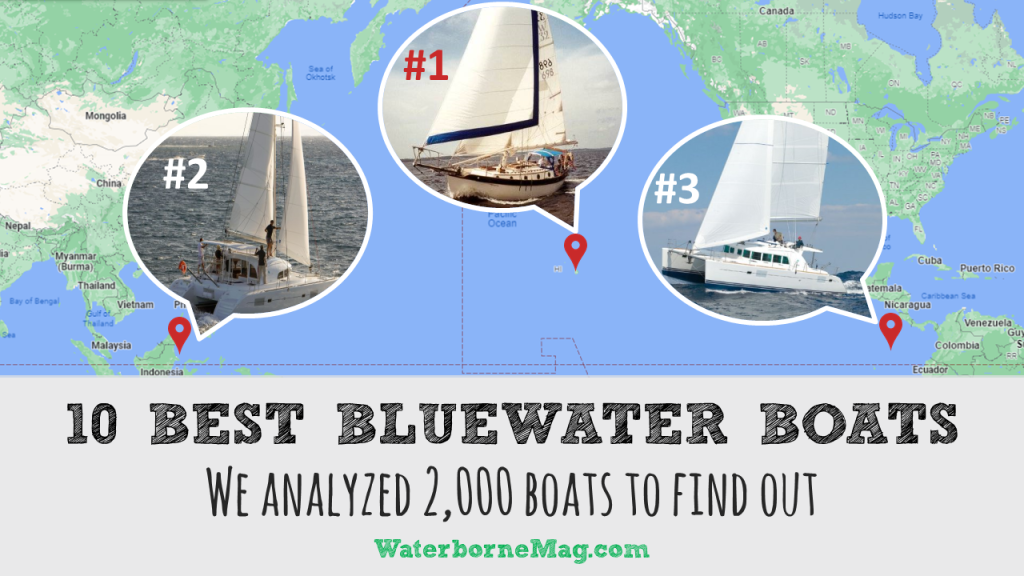
What are the best bluewater sailboats?
This was a question we asked a lot of experienced cruisers when we decided to sail across the Pacific. We needed a boat after all, and we wanted to buy the best bluewater sailboat we could afford.
We heard a lot of strong opinions.
Some sailors thought it was reckless to go offshore in any boat that didn’t have a full keel.
Others prioritized performance, and wouldn’t dream of going anywhere in a slow boat like the Westsail 32 (a.k.a. a “Wet Snail 32”).
Opinions like these left us feeling confused like we had to choose between safety and performance.
If we learned anything from these conversations, it’s that what makes a bluewater boat is a hotly debated topic!
However, there’s a way to cut through all the opinions and get to the bottom of it. The solution is….
We analyzed just under 2,000 boats embarking on ocean crossings (over a 12 year time period) and came up with a list of the ten best bluewater sailboats.
Where did we get our data?
The data for our best bluewater sailboats list comes from 12 years of entries in the Pacific Puddle Jump (PPJ), an annual cross-Pacific rally. We took part in 2017 and had a ball!
You can read about the methodology we used to analyze this data at the bottom of the post.
What do we mean by “best”?
We know, that word is overused on the internet!
Simply, based on our data set, these were the most common makes and models entered in the PPJ cross-Pacific rally. There were at least 10 PPJ rally entries for every make of boat on our top 10 list.
So, these boats are 100% good to go?
No! A bluewater boat isn’t necessarily a seaworthy boat. Almost every cruiser we know made substantial repairs and additions to get their offshore boat ready, adding watermakers , life rafts, solar panels, and more.
Also, you should always have a boat inspected by a professional and accredited marine surveyor before buying it or taking it offshore.
But my bluewater baby boat isn’t on this list!?
There are hundreds of excellent bluewater yachts that are not on this list. For instance, we sailed across the Pacific in a Dufour 35, which didn’t even come close to making our top 10 list.
Choosing the right boat is very much an individual journey.
Where can I find these bluewater boats for sale?
We recognize that a top 10 list won’t get you very far if you’re shopping for a bluewater boat (especially if you’re looking in the used market).
So, to help you find your perfect boat, we’re going to create a big list of bluewater boats that you can use to refine your search on Yachtworld, Craigslist, or any other places to buy a used boat .
Sign up for our newsletter to get our big list of bluewater boats list as soon as it comes out.
We’re also working on a series of posts by size class. For example, if you’re looking for a smaller boat, you can narrow it down to the best bluewater sailboats under 40 feet .
Takeaways from our analysis
There were no big surprises on an individual boat level. All of these makes are considered good cruisers, some of them are even best-selling designs! However, there were a few things that caught our eye.
“Go simple, go small, go now” still holds water
We were thrilled to see the smallest boat in our roundup at the very top of the list! Westsail 32 owners can take pride in their small but mighty yachts (and ignore all those snail-sayers).
While undoubtedly there’s been a trend towards bigger bluewater cruisers in recent years, small cruising sailboats seem to be holding their own. 60% of the monohulls on this list were under 40 feet (if you count the Valiant 40 which sneaks just under at 39.92 feet).
Cat got our tongue
So, we knew catamarans were a thing, but we didn’t fully appreciate HOW popular they’d become!
50% of our top 10 bluewater boat list consists of catamarans—a good fact to toss out the next time you’re trying to garner a happy hour invite on the party boat next door (which will undoubtedly be a catamaran).
Still got it!
We’ve got good news for all you good old boat lovers! 60% of the boats on our list were first built before 2000.
While these older models are less performance-oriented than modern designs, cruisers value these boats for their ability to stand up to rough seas and heavy weather. It just goes to show that solid bones and classic looks never go out of style.
Alright, without further ado, let’s dive into our list of the 10 best bluewater boats!
The 10 best bluewater boats
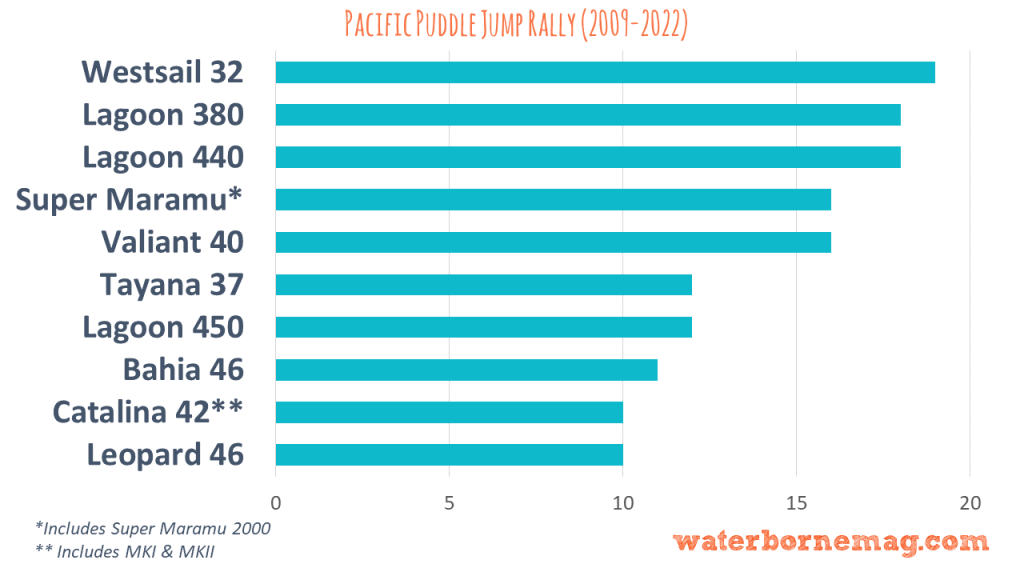
1. Westsail 32

The Westsail 32 is one of the most iconic bluewater cruisers and 19 have set out to cross the Pacific in the PPJ rally since 2009.
In 1973, this small cruising sailboat garnered a 4-page spread in Time magazine. The article inspired many Americans to set sail and the Westsail 32, with its double-ender design, set the standard for what a real bluewater cruiser should look like.
There were approximately 830 built between 1971 and 1980.
This small boat has taken sailors on ocean crossings and circumnavigations. Though considered “slow” by some, the heavily-built Westsail 32 has developed a loyal following for her other excellent offshore cruising characteristics.
If you’re interested in small bluewater sailboats, check out our post on the best small sailboats for sailing around the world .
| LOA | 32.00 ft / 9.75 m |
| First built | 1971 |
| Builder | Westsail (USA) |
| Designer | W. Crealock / W. Atkin |
| Hull type | Long keel, trans. hung rudder |
| Rig type | Cutter |
| Displacement | 19,500 lb / 8,845 kg |
2. Lagoon 380
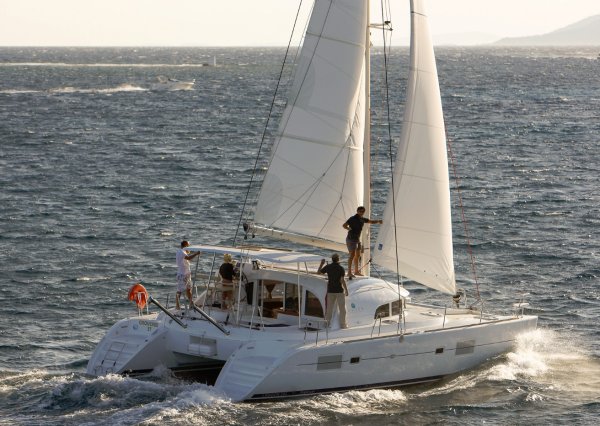
The Lagoon 380 is a reliable, solidly built catamaran and considered roomy for its size. We counted 18 of them in our data set. With over 800 boats built , it may be one of the best-selling catamarans in the world. Like the other boats on this list, the Lagoon 380 has proven itself on long passages and ocean crossings, winning it many loyal fans.
| LOA | 37.89 ft / 11.55 m |
| First built | 2000 |
| Builder | Jeanneau (FRA) |
| Designer | V. Peteghem / L. Prévost |
| type | Cat. twin keel |
| Rig type | Fractional sloop |
| Displacement | 16,005 lb / 7,260 kg |
| More specifications |
3. Lagoon 440
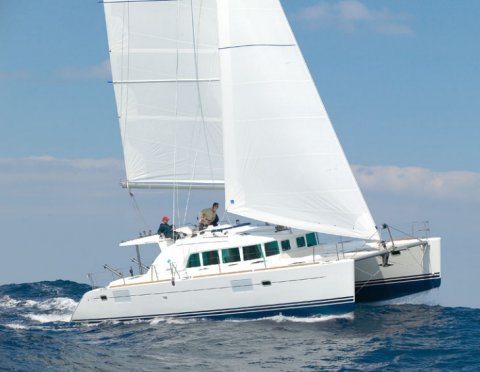
18 Lagoon 440s have set out to cross the Pacific in the PPJ rally since 2009.
Why leave the comforts of home, when you can take them with you? The Lagoon 440 is a luxurious long-range cruiser, offering beautiful wood joinery, spacious accommodations, and a deluxe galley. Oh, and you have the option of an electric boat motor !
SAIL and Sailing Magazine have both done in-depth reviews of the Lagoon 440 if you want to learn more.
| LOA | 44.65 ft / 13.61 m |
| First built | 2004 |
| Builder | Lagoon (FRA) |
| Designer | V. Peteghem / L. Prévost |
| Hull type | Cat. twin keel |
| Rig type | Fractional sloop |
| Displacement | 26,786 lb / 12,150 kg |
4. Amel Super Maramu (incl. SM 2000)
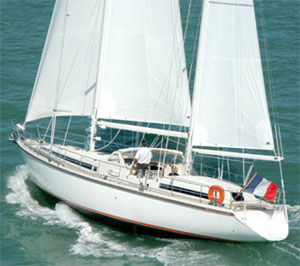
If you follow the adventures of SV Delos on YouTube, you probably know that the star of the show (SV Delos— in case the title didn’t give it away ) is an Amel Super Maramu. These classic bluewater sailboats can be found all over the world, proof they can go the distance.
We counted 16 Amel Super Maramus and Super Maramu 2000s in our list of PPJ entries.
Ready to join the cult of Amel? Read more about the iconic brand in Yachting World.
| LOA | 52.49 ft / 16.00 m |
| First built | 1989 |
| Builder | Amel (FRA) |
| Designer | H. Amel / J. Carteau |
| Hull type | Wing keel |
| Rig type | Masthead ketch |
| Displacement | 35,274 lb / 16,000 kg |
5. Valiant 40
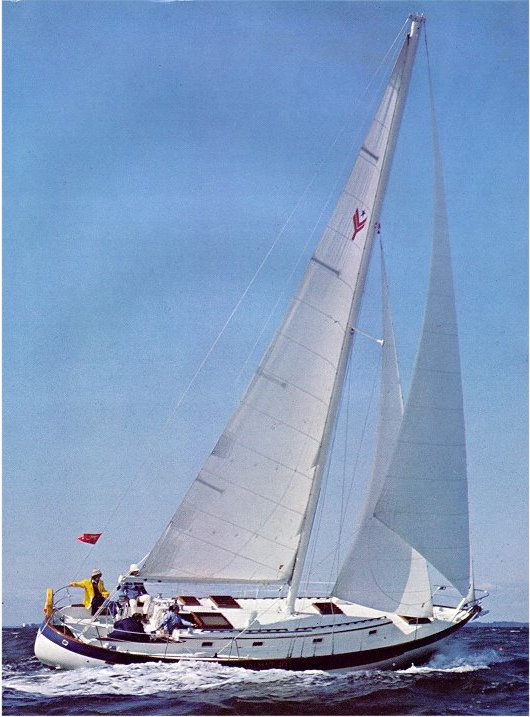
When I interviewed legendary yacht designer, Bob Perry, for Good Old Boat in 2019, he told me that the Valiant 40 was one of the boats that most defined him and marked the real start of his career.
At the time, heavy displacement cruisers were considered sluggish and slow, especially in light winds.
Perry’s innovation with the Valiant 40 was to combine a classic double ender above the waterline, with an IOR racing hull shape below the waterline. The result was the first “performance cruiser”, a blockbuster hit, with over 200 boats built in the 1970s.
It’s no surprise we counted 16 Valiant 40s in our data set.
Cruising World magazine dubbed it “a fast, comfortable, and safe cruising yacht,” and there’s no doubt it’s covered some serious nautical miles.
It’s worth noting that there were blistering problems with hull numbers 120-249 (boats built between 1976 and 1981). Later models did not have this problem. Despite the blistering issues, the Valiant 40 remains one of the most highly thought of bluewater designs.
| LOA | 39.92 ft / 12.17 m |
| First built | 1973 |
| Builder | Uniflite/Valiant (USA) |
| Designer | R. Perry |
| Hull type | Fin keel, rudder on skeg |
| Rig type | Cutter |
| Displacement | 23,520 lb / 10,668 kg |
6. TAYANA 37
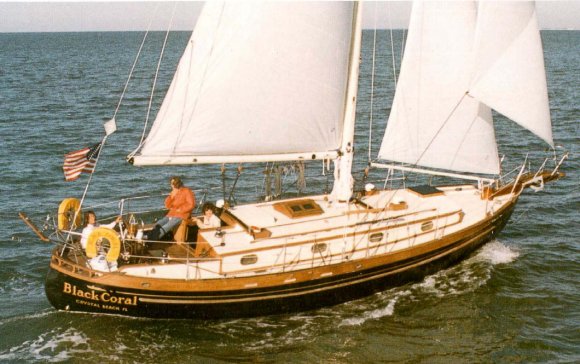
The Tayana 37 is another hugely popular Perry design. The first boat rolled off the production line in 1976 and since then, nearly 600 boats have been built. Beautiful classic lines and a proven track record have won the Tayana 37 a devoted following of offshore enthusiasts.
12 Tayana 37s have set out to cross the Pacific in the PPJ rally since 2009. Read more about the Tayana 37 in this Practical Sailor review .
| LOA | 36.67 ft / 11.18 m |
| First built | 1976 |
| Builder | Ta Yang (TWN) |
| Designer | R. Perry |
| Hull type | Long keel |
| Rig type | Cutter |
| Displacement | 22,500 lb / 10,206 kg |
7. Lagoon 450
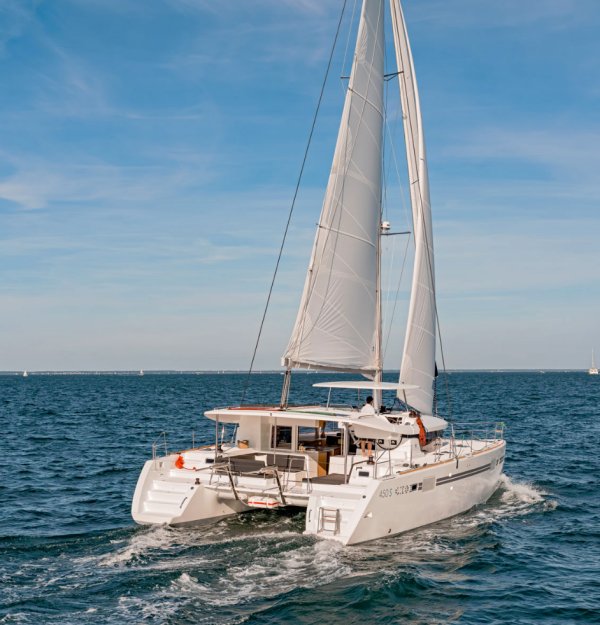
If this list is starting to sound like a paid advertisement, I swear we’re not on Lagoon’s payroll! This is the third Lagoon on our list, but the data doesn’t lie. Lagoon is making some of the best cruising sailboats.
The 450 has been a hot seller for Lagoon, with over 800 built since its launch in 2014. While not a performance cat, the Lagoon 450 travels at a reasonable speed and is brimming with luxury amenities.
At least 12 owners in the PPJ rally chose the Lagoon 450 to take them across the Pacific. It’s no wonder SAIL had so many good things to say about it.
| LOA | 45.80 ft / 13.96 m |
| First built | 2014 |
| Builder | Lagoon (FRA) |
| Designer | V. Peteghem / L. Prévost |
| Hull type | Cat. twin keel |
| Rig type | Fractional sloop |
| Displacement | 33,075 lb / 15,003 kg |
8. Fountaine Pajot Bahia 46
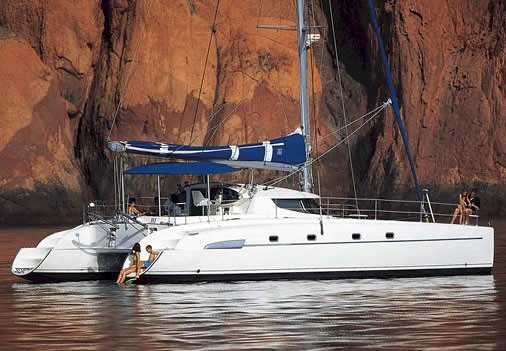
There were 11 Fountaine Pajot Bahia 46s in our data set.
Fountaine Pajot released the Bahia 46 in 1997, a sleek design for traveling long distances. Its generously-sized water and fuel tanks along with ample storage for cruising gear are a real plus for the self-sufficient sailor.
According to Cruising World , “Cruising-cat aficionados should put the Bahia 46 on their “must-see” list.”
| LOA | 46.10 ft / 14.05 m |
| First built | 1997 |
| Builder | Fountaine Pajot (FRA) |
| Designer | Joubert-Nivelt |
| Hull type | Cat. twin keel |
| Rig type | Fractional sloop |
| Displacement | 21,385 lb / 9,700 kg |
| See |
9. Catalina 42 (MKI, MKII)
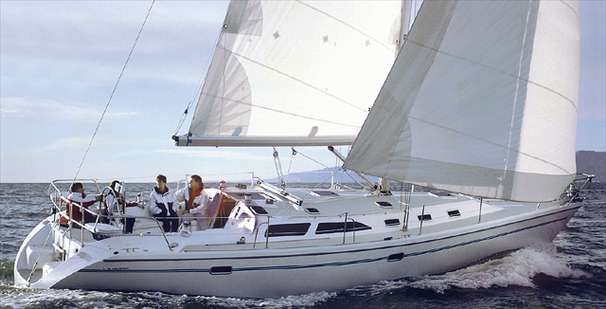
10 Catalina 42s (MKI and MKII) have set out to cross the Pacific in the PPJ rally since 2009.
The Catalina 42 was designed under the guidance of the legendary yacht designer and Catalina’s chief engineer, Gerry Douglas.
One of Catalina’s philosophies is to offer “as much boat for the money as possible,” and the Catalina 42 is no exception. According to Practical Sailor , Catalina aims to price its boats 15% to 20% below major production boats like Hunter and Beneteau.
Practical Sailor has a great in-depth review of the Catalina 42 .
| LOA | 41.86 ft / 12.76 m |
| First built | 1989 |
| Builder | Catalina (USA) |
| Designer | Catalina |
| Hull type | Fin keel, spade rudder |
| Rig type | Masthead sloop |
| Displacement | 20,500 lb / 9,299 kg |
10. Leopard 46
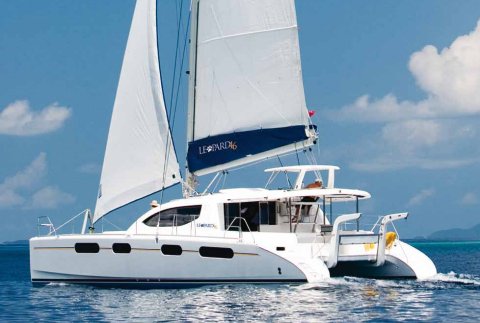
Since 2009, 10 Leopard 46s have embarked on Pacific crossings in the PPJ rally.
Leopards have won legions of fans for their high build quality, robust engineering, and excellent performance.
The Leopard 46 also boasts something of a racing pedigree. It was built in South Africa by Robertson and Caine and designed by Gino Morelli and Pete Melvin, who came up with the record-breaking catamaran Playstation / Cheyenne 125 .
Read more about the Leopard 46 in this Cruising World review .
| LOA | 46.32 ft / 14.12 m |
| First built | 2006 |
| Builder | Robertson & Caine (RSA) |
| Designer | Morelli & Melvin |
| Hull type | Cat. twin keel |
| Rig type | Fractional sloop |
| Displacement | 24,206 lb / 10,980 kg |
Methodology
What the data is and isn’t.
The PPJ data was a real boon because it reflects a wide range of cruising boats: small, big, old, new, expensive, and affordable. We think this may be because the PPJ is a very financially accessible rally—the standard entry cost is $125 or $100 if you’re under 35 (age or boat length!).
We did look at data from other (pricier) rallies but found that the results skewed towards more expensive boats.
Needless to say, the data we used is just a sample of the bluewater boats that crossed the Pacific over the last 10+ years. Many cruisers cross oceans without participating in a rally!
Entries vs. completions
The data we used is a list of the PPJ entries, not necessarily the boats that completed the rally. In instances where we saw the same boat entered multiple years in a row, we assumed they’d postponed their crossing and deleted all but the latest entry to avoid double counting.
Boat make variations
The world of boat building and naming can get pretty complicated. Sometimes a manufacturer changes a boat’s name a year or two into production, other times the name remains the same but the boat undergoes a dramatic update.
For the most part, we’ve used SailboatData.com’s classification system (if they list the boats separately, then we have also), except where there are two separately listed models that have the same LOA, beam, and displacement.
Fiona McGlynn is an award-winning boating writer who created Waterborne as a place to learn about living aboard and traveling the world by sailboat. She has written for boating magazines including BoatUS, SAIL, Cruising World, and Good Old Boat. She’s also a contributing editor at Good Old Boat and BoatUS Magazine. In 2017, Fiona and her husband completed a 3-year, 13,000-mile voyage from Vancouver to Mexico to Australia on their 35-foot sailboat.
Terms and Conditions - Privacy Policy

IMAGES
VIDEO
COMMENTS
Said to be based on the THISTLE design from William Atkin and adapted for fiberglass by William Crealock for Kendall Yacht Corp. (1967). An earlier design, the KENDALL 32, has a flush deck. Westsail added the trunk cabin. Of the 834 hulls built, the first 31 being Kendall 32's, some 400 were sold as kits or bare hulls.
Founded by Lynne and Snyder Vicks. They started the company by purchasing the Kendall 32 molds from Larry Kendall. 31x Kendall 32'S were built before becomming the Westsail 32. In 1977 Hans Weerman purchased the molds, created Westsail International, and built Westsails for two more years. In 1979, Ed Parker, owner of P&M Worldwide, purchased the molds for the W32 and W39. He built 9x W32 ...
Westsail 32 is a 39′ 11″ / 12.2 m monohull sailboat designed by William Atkin, William Crealock, and Colin Archer and built by Westsail Corporation between 1971 and 1981. Great choice! Your favorites are temporarily saved for this session. Sign in to save them permanently, access them on any device, and receive relevant alerts.
A Westsail 32 berthed at Pillar Point Harbor, California. The Westsail 32 was a production fiberglass sailboat built between the years of 1971 and 1980. Approximately 830 were built, about half of them in kit form. [1] The "W32", as they are often referred to, was very heavily built and has taken many people on trouble-free voyages and several ...
The price of a Westsail 32 depends on the condition, equipment, and location of the boat. A new Westsail 32 kit cost about $12,000 in the early 1970s, but most owners spent much more to finish and outfit their boats. A used Westsail 32 can range from $20,000 to $80,000 or more today, depending on the market and the quality of the boat.
The Westsail 32 has reversed the slow reputation it had had in more recent years. Given the light wind conditions that year, David King's captaining of the Westsail 32 Saraband to a Trans-Pacific Cup success in 1988 was impressive. In addition, owners have reportedly recorded weeklong runs of 140 to 160 mile days while sailing in trade winds.
1976 Westsail 32. US$35,500. ↓ Price Drop. La Paz Yacht Sales | La Paz, Mexico. Request Info; Sponsored Boats | related to your search. 2025 NauticStar 212 Legacy. Request price. Iconic Marine Boat Sales & Service | Washington, North Carolina. 1986 Ocean Alexander 50 Mark II. US$225,900.
The Westsail 32 is a 32.0ft cutter designed by William Crealock/W. Atkin and built in fiberglass by Westsail Corporation (USA) between 1971 and 1981. ... The data on this page has been derived from different sources but a significant part is attributed to sailboatdata.com. We thank them for their encouragements and friendly collaboration.
Westsail 32 Video's Westsail 32 Order forms - with prices Dick and Libby Mills are aboard W32 Tarwathie and as live aboards are cruising up and down the eastern seaboard of the US for about 5 years.
Westsail 32 Manual: Engine and Power Specs. Engine manufacturer: Beta : Engine Series: B-38 : Engine Location: Inboard : Engine Hours: 346 : Dimensions And Wieght. Parts And Accessories: Westsail 32 Parts : LOA (Length Overall) 9.75 m / (32.00 ft) L.W.L(Length WaterLine) 8.36 Meters / (27 feet and 5 inch) Dry Weight (Empty)
The Westsail 32 started out life as a flush-deck Kendall 32 when Larry Kendall approached Crealock to design a heavy displacement offshore sailboat along the lines of William Aitken's famous 32 foot double enders Eric and Thistle. It's said when asked how big the market for such a boat, Crealock estimated 10-12 boats. ...
Our sailor's and sailboat owner support team are ready to talk with you about your specific sailing needs, coming regatta, or next sailing adventure. From all at MAURIPRO, let's Go Sailing! Sailboat data, rig dimensions and recommended sail areas for Westsail 32 sailboat. Tech info about rigging, halyards, sheets, mainsail covers and more.
Westsail 32. A sailboat built by Westsail, the 32 is a cutter vessel. Westsail 32 boats are typically used for overnight-cruising, sailing and watersports. Got a specific Westsail 32 in mind? There are currently 2 listings available on Boat Trader by both private sellers and professional boat dealers.
1974 Westsail 32. US$39,000. ↓ Price Drop. Rubicon Yachts | San Mateo, California. Request Info; Sponsored Boats | related to your search. 2025 NauticStar 222L Offshore. Request price. Iconic Marine Boat Sales & Service | Washington, North Carolina. 2001 Tiara Yachts 52 Sport Yacht. US$324,000.
The Westsail 32 is one of the most iconic bluewater cruisers. Built by the Westsail Corporation in the 1970s, this plucky, small sailboat has developed a cult following over the decades. Since 2009, 19 have set out to cross the Pacific in the PPJ rallies. The Westsail 32 is known for its sturdy construction, seaworthiness, and classic looks.
The 10 best bluewater boats. 1. Westsail 32. Photo credit: SailboatData.com. The Westsail 32 is one of the most iconic bluewater cruisers and 19 have set out to cross the Pacific in the PPJ rally since 2009. In 1973, this small cruising sailboat garnered a 4-page spread in Time magazine.
32' Westsail Westsail 32 Boston, Massachusetts Asking $27,480. 19' International Marine West Wight Potter 19 Onekama, Michigan Asking $8,900. 28' Sabre Yachts Sabre 28 MkI Trumansburg, New York Asking $12,000. 35' Com-Pac 35 Southport, North Carolina Asking $92,500. 25' Catalina 25 Anderson SC, South Carolina
1975 Westsail 32 | 32ft. Westbrook, Connecticut. US$44,999 . 700 hours. Own this boat for $398/month. Customize. Engine. Volvo. Total Power. 36hp. Engine Hours. 700. Class. Cutter. Length. 32ft. Year. 1975. ... Email Phone (optional) Contact Broker. Boat Details. Description. The Westsail is from the pages of Bill Crealock and is based off ...
Omsk City coat of arms, 1973-1996 image by Igor Pavlovsky, 08 May 1999 . The shield and year 1716 signify the city's foundation as a fortress in 1716. Two rivers, Irtysh (large) and Om' (small), at the confluence of which the fortress was founded, are represented by blue stripes.
Best Japanese Restaurants in Omsk, Omsk Oblast: Find Tripadvisor traveller reviews of Omsk Japanese restaurants and search by price, location, and more.
The builder, Larry Kendall, only produced a few boats, before he sold the molds and tooling to Westsail Corp. in early 70's. The remainder were built by Westsail. With some design modifications by Crealock, it became the WESTSAIL 32. Thanks to 'Gitanecrew' for corrections on this model.
Most Recent: Reviews ordered by most recent publish date in descending order. Detailed Reviews: Reviews ordered by recency and descriptiveness of user-identified themes such as wait time, length of visit, general tips, and location information.
227th Motorised Rifle Division. 227-я мотострелковая дивизия. Military Unit: 31626. Activated 1978 in Omsk (Svetlyy), Omsk Oblast, as a mobilisation division. The division was unmanned, except for some pre-assigned officers, serving with the parent division (56th Training Motorised Rifle Division). Organisation 1987: